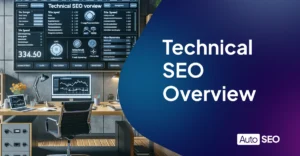Internal Linking

Banish thoughts of stumbling in the dark tunnels of SEO; light your path instead. Unearth the power of internal linking strategies, the humble yet cunning labyrinth builder of the SEO kingdom. Let’s explore the terrain together, journeying through the complex catacombs of digital communication.
Our destintion? Five research-based strategies with proven results, comparing the endless corridors of SEO to navigating an Ikea on a Saturday afternoon; both seemingly intricate yet solvable mazes, if you have the right map in hand. Can you master the craft, transforming your website into a streamlined, user-friendly haven of interconnected wisdom? You bet. This is your comprehensive guide to owning the game of internal linking. Let’s connect those passages.
Table of Contents
Unleashing the Power of Anchor Text in Internal Linking
- Unlock the potential of SEO with tailored anchor text
- Discover the role of anchor text and its impact on search rankings
- Learn to optimize anchor text for internal linking like a pro
Step 1: Understanding Anchor Text
Anchor text, the clickable text in a hyperlink, plays a pivotal role in SEO. It can significantly impact your search engine visibility and directly impact your page rankings. By employing strategic anchor text, it’s possible to guide search engine bots and visitors across a well-thought-out path within your website.
By optimizing your anchor text use, you give search engine algorithms a clearer understanding of your site’s content. Consequently, it contributes to strengthening your positions on SERPs (search engine result pages). In essence, the right anchor text can elevate your SEO strategy, taking it from standard to sterling.
However, knowing the nuances of anchor text optimization isn’t just about understanding its definition. It’s about grasping why and how it impacts your search engine rankings. And, that’s what we’ll uncover now.
Step 2: Optimizing Anchor Text for Internal Links
When it comes to anchor text, the tweak is in the technique. Not every anchor text works equally well — there are best practices to follow and pitfalls to avoid.
For instance, it’s pivotal to choose anchor text that’s relevant to your linked content. Above all, it should enhance the user experience, not detract from it. Long-tail keywords often make great anchor texts as they typically have a direct link to the content.
However, avoid over-optimization at all costs. Search engines aren’t fond of websites that overuse exact match anchor text, perceiving it as ‘spammy’. So, it’s better to maintain a balanced mix of exact match, phrase match, and branded anchor text.
Often, the challenge isn’t just about avoiding the common mistakes. It’s about knowing how to inherently weave them into your content without disrupting the natural flow. And, that’s precisely what we’ll unravel in this section.
Mastering the Art of Link Distribution
- Decoding the role of link distribution in SEO
- Implementing effective strategies for link distribution
- The direct link between distribution and improved user experience
Now that we’ve walked through the power of anchor text in internal linking, a primary thread emerges – the intricate art of link distribution. Do it right, and this art could lead to a gloriously indexed and ranked website. Treasure chests may lie ahead if followed correctly.
The Concept of Link Distribution
Link distribution, quite simply, is the way in which internal and external links are spread across your site. It’s a key element in the SEO universe that doesn’t quite get the limelight it deserves. Yet, a well-balanced link distribution can be like pouring a can of SEO rocket fuel over your site rankings.
Comprehending the crucial role link distribution plays in SEO sets the foundation for crafting a highly optimised website strategy. We notice a couple of interesting phenomena at play here.
Firstly, when link distribution is effectively executed, it directly impacts the user experience. It leads to a fluid flow of navigation across your website, giving your audience a seamless journey, hopping from one asset of value to the next. As a result, website session duration improves, bounce rates drop and the overall experience of your website enhances.
Implementing Effective Link Distribution
The question begs – how does one implement effective link distribution? Embrace this as an opportunity to balance and share your site’s windfall of valuable information evenly. Start by creating a flowchart that maps out your site’s pages. Use this as a guide to deliberately distribute links that are connected logically and make navigational sense.
Numerous studies highlight the benefits of well-executed link distribution. Case in point, a site with balanced link distribution will fare better in search engine ranking compared to a comparable site with a similar number of links but unevenly distributed. If your site falls into the latter category, do not fret. A slight adjustment in your linking strategy can boost your site’s SEO.
Highlighting a case study from our own backyard, we tweaked the internal link distribution for a website struggling in organic search rankings. By auditing and adjusting the spread of its internal links, we were able to augment its visibility on search engine results significantly. A richer user experience and a lift in organic traffic were the sweet fruits of this effort.
When done right, the art of link distribution can nudge your SEO strategy from “just another website” to “an authority in the field”. It’s about making every link count and every user session worthwhile – setting the stage for a holistic SEO approach.
Leveraging Content Hubs for Internal Linking
- Content hubs serve as powerhouses for internal linking.
- Establishing these hubs elevates website structure and user navigation.
- Building a content hub involves strategic linking of related content.
The Power of Content Hubs
A nifty concept that’s been garnering attention is that of ‘content hubs’. These are essentially central pages, or hub pages, which are rich in content about a particular topic.
SEO benefits from content hubs? Immense! They provide a hierarchical structure of related content, which search engines love. It’s like mapping out a content theme with related subtopics, making your website’s architecture organised and easy to index.
On the flip side, content hubs also elevate user navigation. Think of your website as an uncharted territory for a user. A well-defined, purposeful content hub can act as a GPS, guiding the users efficiently through relevant content. So, content hubs not only offer SEO benefits but also enhance user experience through structured navigation.
Building Your Own Content Hubs
Embarking on the journey of creating your own content hubs? Here are some stepping stones to guide you through:
- Start with the core – Choose a broad topic relevant to your niche to serve as the hub theme.
- Identify subtopics – These are related narrower topics that revolve around the hub theme.
- Create quality content – Generate rich content on each subtopic and link them back to the hub page.
Successfully implemented, a content hub constructs a thematic cluster of related content, offering numerous pathways for internal linking. However, it’s not just about cramming in as many links as possible. Linking should be meaningful, enhancing user understanding of the related content while making navigation a breeze.
Tips for linking strategy – Consider linking in two ways: ‘hub-to-spoke’, where your main hub page links to each related piece of content. Then, ‘spoke-to-hub’, where each piece of content links back to the main hub page. For extra punch, also consider ‘spoke-to-spoke’ links, connecting related pieces together. This strategy forms a tightly knit web, maximizing the reach of each piece and boosting the overall SEO potential of your site.
Care to unwrap more about internal linking strategies? Read on!
Understanding the Role of Nofollow Links in SEO
- Nofollow links are less mysterious than you think.
- They play a substantial role in directing the SEO flow and come with their unique benefits when used strategically.
Demystifying Nofollow Links
Nofollow links seem to be shrouded in mystery but they’re actually quite straightforward. On the surface, they are regular links with a ‘nofollow’ attribute. But, under the hood, they serve a special purpose. They instruct search engine bots not to follow them, thereby not passing on any SEO value.
So why use them? They add contextual value to the content for the human reader and create a more natural, diversified link profile. This ensures that search engines don’t see your internal link structure as manipulative.
Different search engines interpret these nofollow links differently. While Google disregards them from a ranking point of view, other search engines such as Bing may not.
The Impact of Nofollow Links on SEO
While nofollow links might not directly influence your site’s SEO rankings, their existence is indispensable. SEO is no longer about just accumulating inbound links, but about building a user-oriented experience. Nofollow links form an integral part of this user-focused approach, as they enrich the content by providing additional, relevant information.
These links can also balance your SEO strategy by diluting the over-optimized anchor text distribution, providing a more natural footprint for search engines to crawl.
When to Use Nofollow Links
Utilizing nofollow links strategically is key. They can be beneficial in certain situations such as when linking to potentially harmful sites or in user-generated-content where you do not have control over the linked content.
They’re also used when you don’t want to endorse a website or a page, or to stop search engines from following the links in advertisements, sponsored posts, and paid links where conflict of interest can arise.
How to Properly Implement Nofollow Links in Your Internal Linking Strategy
Implementing nofollow links in your internal linking strategy involves introducing them in areas where you may not want search engines to crawl, such as login pages or private user data.
The art lies in understanding their dynamics and using them to strike a balance in your SEO strategy. While executing them, ensure you’re adding them responsibly, and remember, your primary focus should be on delivering valuable content to human readers.
Toying around with nofollow links is not a role of a dice but a calculated move. Feel the rhythm of your audience, web pages, and search engines to ensure the tunes of your content and SEO dance harmoniously.
Implementing Internal Linking with SEO Tools
- Capitalize on SEO tools to streamline internal linking
- Tailor-made SEO tools that facilitate effective internal linking
- Practical guide to using SEO tools for internal linking
Taking the fundamental understanding of nofollow links from our previous section, let’s enhance this understanding by employing SEO tools for internal linking. This could be a significant game-changer in your overall SEO strategy.
The Importance of SEO Tools in Internal Linking
SEO tools serve as a shortcut to a quick, efficient, and, most importantly, effective internal linking strategy. These tools provide an overview of your website’s structure, helping you identify where to add internal links for maximum SEO gains. Certain SEO tools can even suggest potential internal linking opportunities based on keyphrase similarities amongst your webpages.
For example, Ahrefs’ Site Audit Tool and SEMRush’s On Page SEO Checker both feature options for internal linking opportunities. These not only provide a helpful dive into your website’s linking structure but can actively assist you in identifying and implementing optimal links.
With these tools, internal linking isn’t a shot in the dark, rather a well-planned, conscious approach to improving your SEO.
Using SEO Tools for Internal Linking
Having understood its importance, let’s focus on how to use SEO tools for internal linking.
Step-by-step guide on using SEO tools for internal linking
Start with your preferred SEO tool, like Screaming Frog’s SEO Spider tool or Moz’s Link Explorer. These tools thrive in their ability to crawl your website to examine the overall link structure. This information gives you a detailed overview of your internal linking, helping you identify bottlenecks or gaps where new links could prove beneficial.
Make use of the tool’s suggestions for new internal links. These suggestions are based on a page’s content, relevancy, and existing external links. Inserting the recommended links can help build an authoritative, coherent, and efficient internal linking structure.
Tips for maximizing the benefits of SEO tools
Don’t just follow suggestions blindly. Carefully review each suggested link to ensure it’s relevant and adds value to your user’s journey through your website.
Relevance is key when it comes to internal linking. An SEO tool may suggest a link based on similarities in content, but if it doesn’t make sense in the reader’s journey, it’s best to skip it.
Have a consistent review process in place. With content changes, new pages, and link aging, some links might become obsolete or less relevant. Hence, a regular review and update process will ensure your internal linking stays up-to-date, salient, and effective.
Remember, the power of internal linking lies in improving user experience and your website’s SEO ranking simultaneously. Leveraging SEO tools could be your pathway to significantly heightened results.
Tying it up: The Power of Smart Internal Linking
So, we’ve tackled five solid strategies: contextual relevance, anchor text optimization, deep linking, traffic-focused linkage, and the cornerstone cluster approach. Each one a jewel worth adding to your SEO crown.
Your site’s internal linking is more than just a navigational tool. It’s a key player in your SEO game, directing Google’s crawlers, dictating site structure, and enhancing user experience.
Now it’s time to turn knowledge into action. Start with assessing your site’s current linking pattern, then step by step, incorporate these strategies. Remember, it’s not an overnight process; be patient and consistent.
Let’s switch to a brainstorming gear. How can you use these strategies to drive traffic to your lesser viewed pages? Time to delve deeper and draft a concrete plan.
So, ready to optimize your site’s architecture and lay the foundation for better SEO? The power is in your hands!

Written by Peter Selmeczy
As the Head of Growth at AutoSEO I love everything about content, SEO, and AI. Hope you like my musings and would love to talk to you in the comments.



